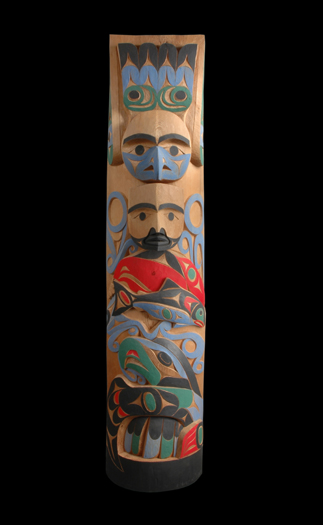Tim Paul was born in the town of Zaballos, which is situated on the west coast of Vancouver Island. Tim is a member of the Hesquiaht First Nation, located in the central region of the Nuu-chah-nulth Tribal Council territory.
Tim grew up in a small village of eight families, on the northern end of Nootka Island. His great-grandfather, John Smith, often trapped salmon in a local stream. The Department of Fisheries and Oceans did not approve of John’s fishing or his weir and removed it on three occasions. It was difficult for John Smith to abandon his traditional fishing ways.
The northern end of Nootka Island was once very beautiful, with three pristine water- sheds. Over the years logging has damaged these watersheds and disrupted the riparian zones. This mis-management of our forests troubles Tim very much. He has a photo above his carving bench of a clear-cut zone that extends right to the shores of a lake near his old village.
Tim is upset with the harmful logging practices that occur in our province, and has been working on a documentary on Hornby Island. Hornby Island is located in the Straight of Georgia, just north of Qualicum Beach. The purpose of the film is to depict nature as Natives see it. Tim explains, “We are related to nature and it is devastating to always just take, take, take.” Tim would like to see our forests managed more respectfully.
Tim is a very spiritual person and knows many of the oral stories that have been passed down by his grandfathers. He uses his carvings and sculptures as a medium to pass on this information that is so important in his culture. Tim is dedicated to continuing the traditions of his society through the distribution of his artwork.
Tim has traveled around the world and performed Westcoast dances and songs with his troupe. He is very fascinated with other indigenous cultures from around the world, such as the Druids of England and the Sami of Sweden. He believes that we can work together to promote awareness of our cultures, and is involved with the Druids and Sami natives.
Tim Paul apprenticed with Richard Hunt and Art Thompson as well as other Westcoast carvers. In 1977 he became assistant carver at the Royal British Columbia Museum‘s carving program at Thunderbird Park, and in 1984 he became the senior carver. He now works with a number of apprentices teaching Nuu-chah-nulth culture to the next generation.
Tim carves masks, rattles, bowls, canoes, sculptures and totem poles. He was selected to be the main carver for the Hesquiaht pole at the Canadian Museum of Civilization. His work can be found in numerous public and private collections worldwide.
Tim has work published in over 27 books and exhibition catalogues. His artwork has been used by galleries for advertisements in a number of the American Indian Art Magazine issues: Fall 1979; winter 1988; fall 1994; summer 1997; spring 2000.

